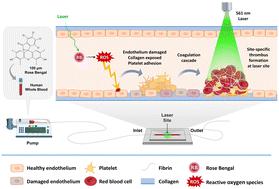Our official English website, www.x-mol.net, welcomes your feedback! (Note: you will need to create a separate account there.)
Site-specific thrombus formation: advancements in photothrombosis-on-a-chip technology
Lab on a Chip ( IF 6.1 ) Pub Date : 2024-06-04 , DOI: 10.1039/d4lc00216d Kuan-Ting Liu, Pai-Wen Wang, Han-Yun Hsieh, Han-Chi Pan, Hsian-Jean Chin, Che-Wei Lin, Yu-Jen Huang, Yung-Chieh Liao, Ya-Chun Tsai, Shang-Ru Liu, I.-Chang Su, Yen-Fang Song, Gung-Chian Yin, Kuang-Chong Wu, Er-Yuan Chuang, Yu-Jui (Ray) Fan, Jiashing Yu
Lab on a Chip ( IF 6.1 ) Pub Date : 2024-06-04 , DOI: 10.1039/d4lc00216d Kuan-Ting Liu, Pai-Wen Wang, Han-Yun Hsieh, Han-Chi Pan, Hsian-Jean Chin, Che-Wei Lin, Yu-Jen Huang, Yung-Chieh Liao, Ya-Chun Tsai, Shang-Ru Liu, I.-Chang Su, Yen-Fang Song, Gung-Chian Yin, Kuang-Chong Wu, Er-Yuan Chuang, Yu-Jui (Ray) Fan, Jiashing Yu

|
Thrombosis, characterized by blood clot formation within vessels, poses a significant medical challenge. Despite extensive research, the development of effective thrombosis therapies is hindered by substantial costs, lengthy development times, and high failure rates in medication commercialization. Conventional pre-clinical models often oversimplify cardiovascular disease, leading to a disparity between experimental results and human physiological responses. In response, we have engineered a photothrombosis-on-a-chip system. This microfluidic model integrates human endothelium, human whole blood, and blood flow dynamics and employs the photothrombotic method. It enables precise, site-specific thrombus induction through controlled laser irradiation, effectively mimicking both normal and thrombotic physiological conditions on a single chip. Additionally, the system allows for the fine-tuning of thrombus occlusion levels via laser parameter adjustments, offering a flexible thrombus model with varying degrees of obstruction. Additionally, the formation and progression of thrombosis noted on the chip closely resemble the thrombotic conditions observed in mice in previous studies. In the experiments, we perfused recalcified whole blood with Rose Bengal into an endothelialized microchannel and initiated photothrombosis using green laser irradiation. Various imaging methods verified the model's ability to precisely control thrombus formation and occlusion levels. The effectiveness of clinical drugs, including heparin and rt-PA, was assessed, confirming the chip's potential in drug screening applications. In summary, the photothrombosis-on-a-chip system significantly advances human thrombosis modeling. Its precise control over thrombus formation, flexibility in the thrombus severity levels, and capability to simulate dual physiological states on a single platform make it an invaluable tool for targeted drug testing, furthering the development of organ-on-a-chip drug screening techniques.
中文翻译:

位点特异性血栓形成:芯片光血栓技术的进步
血栓形成的特征是血管内形成血凝块,这是一个重大的医学挑战。尽管进行了广泛的研究,但有效的血栓形成疗法的开发仍受到高昂的成本、漫长的开发时间和药物商业化的高失败率的阻碍。传统的临床前模型往往过于简单化心血管疾病,导致实验结果与人类生理反应之间存在差异。作为回应,我们设计了一种光血栓芯片系统。该微流体模型集成了人内皮、人全血和血流动力学,并采用光血栓方法。它通过受控激光照射实现精确的、特定部位的血栓诱导,在单个芯片上有效地模拟正常和血栓的生理条件。此外,该系统还可以通过激光参数调整来微调血栓闭塞水平,从而提供具有不同闭塞程度的灵活血栓模型。此外,芯片上记录的血栓形成和进展与之前研究中在小鼠中观察到的血栓状况非常相似。在实验中,我们将含有孟加拉玫瑰的再钙化全血灌注到内皮化微通道中,并使用绿色激光照射引发光血栓形成。各种成像方法验证了该模型精确控制血栓形成和闭塞水平的能力。对肝素和 rt-PA 等临床药物的有效性进行了评估,证实了该芯片在药物筛选应用中的潜力。总之,芯片光血栓形成系统显着推进了人类血栓形成建模。 它对血栓形成的精确控制、血栓严重程度的灵活性以及在单一平台上模拟双重生理状态的能力,使其成为靶向药物测试的宝贵工具,进一步推动了器官芯片药物筛选技术的发展。
更新日期:2024-06-04
中文翻译:

位点特异性血栓形成:芯片光血栓技术的进步
血栓形成的特征是血管内形成血凝块,这是一个重大的医学挑战。尽管进行了广泛的研究,但有效的血栓形成疗法的开发仍受到高昂的成本、漫长的开发时间和药物商业化的高失败率的阻碍。传统的临床前模型往往过于简单化心血管疾病,导致实验结果与人类生理反应之间存在差异。作为回应,我们设计了一种光血栓芯片系统。该微流体模型集成了人内皮、人全血和血流动力学,并采用光血栓方法。它通过受控激光照射实现精确的、特定部位的血栓诱导,在单个芯片上有效地模拟正常和血栓的生理条件。此外,该系统还可以通过激光参数调整来微调血栓闭塞水平,从而提供具有不同闭塞程度的灵活血栓模型。此外,芯片上记录的血栓形成和进展与之前研究中在小鼠中观察到的血栓状况非常相似。在实验中,我们将含有孟加拉玫瑰的再钙化全血灌注到内皮化微通道中,并使用绿色激光照射引发光血栓形成。各种成像方法验证了该模型精确控制血栓形成和闭塞水平的能力。对肝素和 rt-PA 等临床药物的有效性进行了评估,证实了该芯片在药物筛选应用中的潜力。总之,芯片光血栓形成系统显着推进了人类血栓形成建模。 它对血栓形成的精确控制、血栓严重程度的灵活性以及在单一平台上模拟双重生理状态的能力,使其成为靶向药物测试的宝贵工具,进一步推动了器官芯片药物筛选技术的发展。












































 京公网安备 11010802027423号
京公网安备 11010802027423号